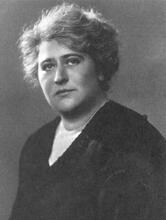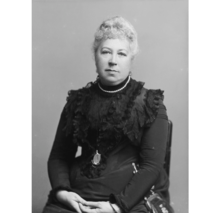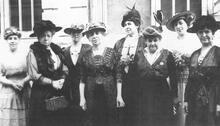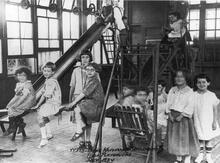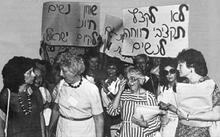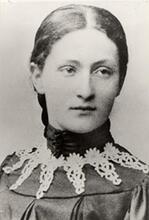Union of Jewish Women
Influenced by their American counterparts, Anglo-Jewish women organized a Conference of Jewish Women in 1902. This conference led directly to the foundation of a national organization, the Union of Jewish Women. The UJW determined the social service agenda for English Jewish women until World War I. Its success was rooted in following the precedents set by Jewish women’s social service organizations abroad and gentile women’s activism in Britain, and adapting them for the specific needs of the Anglo-Jewish community. The UJW adopted the ostensibly scientific methods of social service promoted by the late Victorian “scientific philanthropy” movement. Its professional staff trained upper- and middle-class Anglo-Jewish women as volunteers for a range of educational and philanthropic organizations, serving as a direct link between charitable institutions and women who needed help.
Formation of the Union of Jewish Women
By the end of the nineteenth century, Jewish women in England had emerged out of the home and into the public sphere, thanks to the leadership of a coterie of aristocratic Anglo-Jewish women who had ventured into social service as volunteers in the middle of the century (see Louise Lady Rothschild). As opportunities expanded, these aristocratic figures brought middle class Jewish women into the field as paid professional social workers. Then, as a vast wave of Eastern European Jewish immigrants flooded England’s shores in the 1880s, significant numbers of upper- and middle-class Jewish women gradually became prominent in social service to fill the urgent need to help this new wave of Jewish poor.
The Jewish women of the United Kingdom were influenced by their American counterparts, who had been organizing in increasingly elaborate and sophisticated forms since the Jewish Women’s Congress of 1893, which had led directly to the foundation of the National Council of Jewish Women. Two of the organizers of the Congress and NCJW, Sadie American and Julia Richman, traveled to England in 1899 to meet with their Anglo-Jewish counterparts and encourage them to organize in a similar fashion. These developments led to the 1902 Conference of Jewish Women, which, like the 1893 Congress before it, ended in the foundation of a national organization—the Union of Jewish Women (UJW). The UJW determined the social service agenda for Jewish women until World War I. Its success was rooted in following the precedents set by Jewish women’s social service organizations abroad and gentile women’s activism in Britain, and adapting them for the specific needs of the Anglo-Jewish community.
Leadership
The well-connected leadership of the UJW took care to leverage its social power as it initially vied for publicity and new members. Leaders included Julia Cohen, whose husband’s family was heavily involved in London’s Jewish Board of Guardians, and several Rothschilds and other prominent Anglo-Jewish women. The leadership also reflected the UJW’s link to the secular movement for women’s rights that was then sweeping Western Europe and America. The chair of the International Council of Women (ICW) joined the Executive Committee, initiating the process that eventually led the ICW to join the international women’s movement, drawing the UJW closer to the broader women’s movement simultaneously. The ICW was the umbrella organization for women’s social service organizations around the world and its leader’s presence on the UJW’s Executive Committee publicly identified that organization as part of the international women’s movement.
Indeed, the Union declared itself to be an “all-embracing sisterhood,” forming a “bond between Jewish women of all degrees and all shades of opinion, religious, social and intellectual.” That said, the UJW before World War I was composed primarily of upper-class women who came in contact with the working class only when providing charitable services.
Strategy
The UJW adopted the ostensibly scientific methods of social service promoted by the late Victorian “scientific philanthropy” movement, which sought to measure and quantify charitable work in the same manner as commerce. Other Jewish philanthropic organizations, including the Jewish Association for the Protection of Girls and Women (JAPGW), also utilized this structure, which encouraged collection and analysis of quantitative data for any given cause.
The UJW concentrated only on helping “the better educated Jewess.” Its professional staff trained upper- and middle-class Anglo-Jewish women as volunteers for a range of educational and philanthropic organizations. Avoiding charities benefiting from the male-run Jewish Board of Guardians, the UJW served as a direct link between charitable institutions and women who needed help.
The Union organized a system of volunteers trained to help gentlewomen seeking employment and to assist Jewish charitable institutions. The UJW’s small loan fund supported a limited amount of job training and personal assistance to gentlewomen in temporary need, “allowing them to tide over a difficult period.” By the end of its first year, the UJW was hailed by the London Jewish Chronicle as more effective than its male-run counterparts.
By the end of the Union’s first few years, its education and job training programs helped to increase middle-class Jewish women’s financial security and social mobility. The UJW’s large-scale enrollment of volunteers and vocational education for “gentlewomen” also substantially increased opportunities for female Jewish volunteers, nurses, social workers, and teachers in the Jewish community. These accomplishments laid the groundwork for the expansion of the UJW in years to come, when it would effectively function as a clearinghouse for a broad range of educational, charitable, and professional services.
Expansion and Affiliations
By 1912, the Union expanded its training program. Boasting roughly1,600 members throughout Great Britain and the colonies, the UJW’s training program placed women as social workers, teachers, nurses, secretaries, embroiderers, gardeners, kindergarten teachers, lamp-shade makers, seamstresses, printers, photographers and even musicians and singers. By the eve of World War I, the Union also placed women as “plan tracers” for architects, physical drill and dancing instructors and accountants. Aware of antisemitic discrimination against Jewish doctors and nurses, the Union helped mount a community-wide campaign to build Beth Holim Hospital.
Rejected for membership by the male-run Jewish Board of Guardians, both due to its status as a women’s organization and its clashes with the Board over issues such as women’s involvement in the synagogue, the Union aligned itself with secular women’s organizations. Constance Lady Battersea, daughter of Louise Lady Rothschild, had been elected president of the National Union of Women Workers in 1901. She persuaded the UJW to affiliate with a number of national and international women’s organizations, including the NUWW and, in 1904, the International Council of Women.
As early as 1913 the Union expanded its mandate to include international feminist goals: equal employment, improved living conditions and political and religious rights for working-class as well as middle-class Jewish women. The UJW even cooperated in creating the International Council of Jewish Women in 1923. The wider focus and expanding range of collaboration led to the Union’s broadening its mandate to seek political, religious and communal change for women of all classes, along similar lines to America’s NCJW and the International Council of Women. The result was UJW establishment of settlement houses in the Jewish East End of London and support of Jewish religious and national English secular suffrage campaigns.
The election of Gertrude Spielman to the UJW presidency in 1918 was a particular turning point for the Union’s outlook across class lines. Spielman, an aristocrat herself who was active in a wide variety of working-class Jewish philanthropic organizations, including the Stepney Jewish Girls’ Club and Settlement and the Jewish Ladies’ Clothing Association, made work across class lines a priority under her presidency. Early in her tenure, Spielman said she “hoped the union would in future sweep away artificial restrictions as between one class of workers and another, so that every question relating to Jewish womanhood should come within its purview.” The Union now also trained Jewish women as social workers, dentists and even policewomen. It added affiliate social service organizations concerned with Jewish women and children.
Involved in a mix of English social feminist and Jewish projects, the Union worked closely with suffragist leader Millicent Garrett Fawcett and affiliated with the socialist Fabian Women’s Group. Insisting that Jewish women use their recently acquired political power, the UJW lobbied for improved services and protective legislation for working-class women and children and helped to build the Jewish community’s War Memorial with its educational programs in the East End of London.
Addressing Inequality in Jewish Religious and Communal Life
Expanding upon its members’ desire for greater influence in their own community, the UJW undertook a campaign of equality in all aspects of Jewish religious and communal life. It won confirmation of girls and mixed seating in synagogues that had not permitted them and won votes for women in several liberal synagogues. The Union also persuaded seven synagogues to pass resolutions in favor of confirmation classes for girls by 1923. In the same year it began a campaign for mixed seating at the West London Synagogue. The UJW’s campaign for women’s rights in the synagogue was widely opposed by male-dominated organizations. Nevertheless, England’s Liberal and Reform synagogues, influenced by the UJW and other Jewish women’s groups, began to involve women in Jewish ritual and study.
All of these changes strengthened the case for granting voting rights to women in England. The Union had not formally taken a position on suffrage before the war, but now its members demanded participation in the national and Jewish campaigns for universal suffrage. The UJW affiliated with several English suffrage groups and revived a prewar campaign by the activist Jewish League for Woman Suffrage to secure the franchise for women seatholders in all congregations affiliated with the umbrella United Synagogue. By 1918, as a result of work by the Jewish League for Woman Suffrage, seven synagogues had granted the franchise to women. By 1920, thanks to the UJW’s efforts, sixteen out of eighteen synagogues in the United Synagogue granted the franchise to women seatholders.
By the late 1920s, thanks in part to the UJW, Anglo-Jewish women’s progress in the synagogue had also increased their communal influence. Jewish women served on the boards of many Anglo-Jewish synagogues and communal institutions and were involved in discussions affecting internal communal life. Moreover, the UJW had helped build a thriving network of Jewish women’s philanthropic and professional collaboration. Although the Union itself ceased to exist in 1930, as the suffrage movement was no longer relevant and most issues it had campaigned for in religious life had been addressed, this network served as its legacy.
Gibbon, Monk. Netta. London: Routledge and Keegan Paul, 1960
Kuzmack, Linda Gordon. Woman’s Cause: Jewish Woman’s Movement in England and the United States, 1881–1933. Columbus, OH: Ohio State University press, 1990.
Lipman, V. D. Social History of the Jews in England, 1850–1950. London: Watts, 1954
London Jewish Chronicle (1902–1933).
London Jewish Guardian (1921–1926).
The Jewish World (London), (1890-1934).
Union of Jewish Women. Leaflet. London: 1914.
Union of Jewish Women. Reports 1902–1933. London: 1933.

